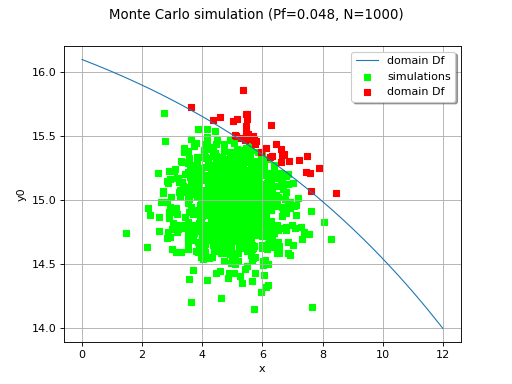Monte Carlo simulation¶
Using the probability distribution the probability distribution of a random
vector , we seek to evaluate the following probability:
Here, is a random vector,
a deterministic
vector,
the function known as limit state function
which enables the definition of the event
.
If we have the set of N
independent samples of the random vector
,
we can estimate
as follows:
where
describes the indicator function equal to 1 if
and equal to 0 otherwise; the idea here is in fact to estimate the required
probability by the proportion of cases, among the N samples of
,
for which the event
occurs.
By the law of large numbers, we know that this estimation converges to the
required value as the sample size N tends to infinity.
The Central Limit Theorem allows one to build an asymptotic confidence interval using the normal limit distribution as follows:
with
and is the
-quantile of the standard normal distribution.
One can also use a convergence indicator that is independent of the confidence level $alpha$: the coefficient of variation, which is the ratio between the asymptotic standard deviation of the estimate and its mean value. It is a relative measure of dispersion given by:
It must be emphasized that these results are asymptotic and as such needs that .
The convergence to the standard normal distribution is dominated by the skewness
of
divided by the sample size N, it means
.
In the usual case
, the distribution is highly skewed and this
term is approximately equal to
.
A rule of thumb is that if
with
, the asymptotic nature of the Central Limit Theorem is not problematic.
(Source code, png)

The method is also referred to as Direct sampling, Crude Monte Carlo method, Classical Monte Carlo integration.
 OpenTURNS
OpenTURNS